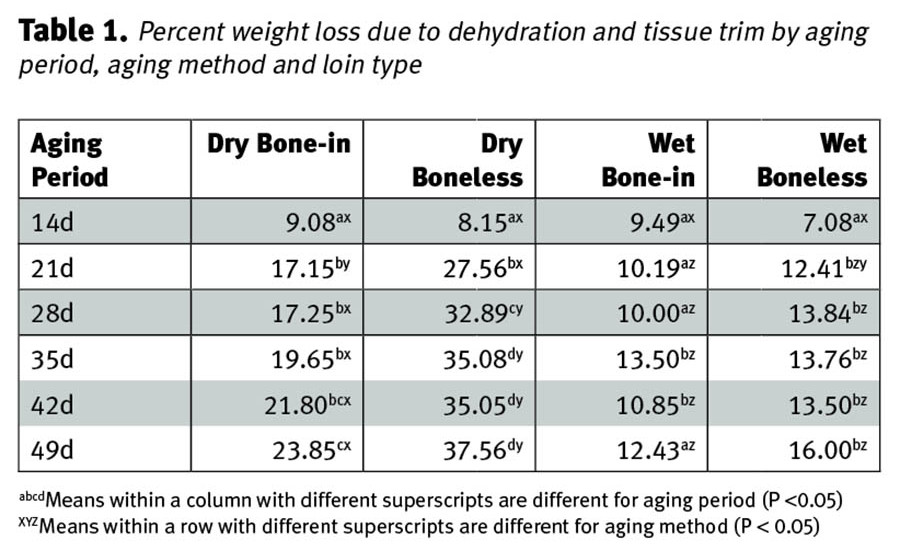Meat Science Review
Can aging improve low-marbled beef?
Effects of post-mortem aging time and type on palatability of low-marbled beef loins.

Table 1. Percent weight loss due to dehydration and tissue trim by aging period, aging method and loin type
Approximately 60 percent of steaks available at retail are USDA Select and low Choice. Of those categories, one in four Select and one in five low Choice steaks will be tough (George etal 1999). Tenderness followed by flavor are the most important palatability traits for beef consumers (Beerman 2009). More information regarding aging low-marbled beef is needed.
Our study utilized 96 short loins (NAMPS 174) and 96 strip loins (NAMPS 180) selected with marbling scores between Slight50 and Small50 that were vacuum-packaged at the plant. Loins were weighed and designated bone-in or boneless and aged as wet (remained in bag) or dry (unpackaged and suspended in a muslin sock in a controlled aging cooler) for 14, 21, 28, 35, 42 and 49 days. After aging, loins were processed into 2.5 cm thick steaks for shear force and trained taste panel evaluation.
Both mechanical and taste panel tenderness improved from day 14 through 49 regardless of wet or dry, bone-in or boneless designation with very little improvement after 21 days. All steaks could be classified as “very tender” (Avg shear force <2.8 kg) according to Belew etal (2003). Panelist rated steaks aged longer than 21 days as more tender than those aged 14 to 21 days.
For flavor components, day 14 aged flavor was less intense than 42 or 49 but not different from intervening days. Peak aged flavor occurred at 42 days and boneless samples had more aged flavor than bone-in (P=.006).
The decision to wet or dry age beef is often based on potential weight loss. Weight losses across category are presented in Table 1.
Low-marbled beef loins aged longer than 28 days do not significantly improve in tenderness. “Aged flavor” was the only palatability attribute affected by aging period, bone-in/boneless status, or dry/wet aging method. Dry aging of loins with marbling less than SM50 is not practical given the increased loss of product and the lack of improvement in flavor attributes. NP
A.N. Lepper-Blilie is with Hormel Foods Corporate Services in Austin, Minn. E.P. Berg, D.S. Buchanan and P.T. Berg are with the Department of Animal Sciences at North Dakota State University in Fargo, N.D. For more information, contact the primary author at eric.p.berg@ndsu.edu.
Looking for a reprint of this article?
From high-res PDFs to custom plaques, order your copy today!





